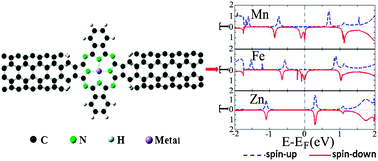Spin transport properties of 3d transition metal(ii) phthalocyanines in contact with single-walled carbon nanotubeelectrodes†
Abstract
The spin

* Corresponding authors
a
Key Laboratory for the Physics and Chemistry of Nanodevices, Department of Electronics, Peking University, Beijing 100871, China
E-mail:
smhou@pku.edu.cn
b Division of Physical Chemistry, Department of Chemistry, University of Modena and Reggio Emilia, 41100 Modena, Italy
c Center for Organic Electronics and Photonics, School of Chemistry and Biochemistry, Georgia Institute of Technology, Atlanta, USA
d School of Physics and CRANN, Trinity College, Dublin 2, Ireland
The spin

 Please wait while we load your content...
Something went wrong. Try again?
Please wait while we load your content...
Something went wrong. Try again?
X. Shen, L. Sun, Z. Yi, E. Benassi, R. Zhang, Z. Shen, S. Sanvito and S. Hou, Phys. Chem. Chem. Phys., 2010, 12, 10805 DOI: 10.1039/C002301A
To request permission to reproduce material from this article, please go to the Copyright Clearance Center request page.
If you are an author contributing to an RSC publication, you do not need to request permission provided correct acknowledgement is given.
If you are the author of this article, you do not need to request permission to reproduce figures and diagrams provided correct acknowledgement is given. If you want to reproduce the whole article in a third-party publication (excluding your thesis/dissertation for which permission is not required) please go to the Copyright Clearance Center request page.
Read more about how to correctly acknowledge RSC content.
 Fetching data from CrossRef.
Fetching data from CrossRef.
This may take some time to load.
Loading related content
